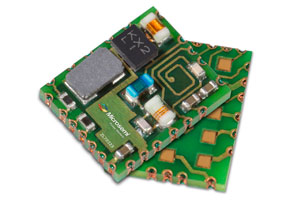Microsemi Corporation (Nasdaq: MSCC), a provider of semiconductor solutions differentiated by power, security, reliability and performance, announced the availability of the smallest radio module it has ever produced. The ZL70323 is optimised for implantable medical devices such as pacemakers, cardiac defibrillators and neurostimulators—measuring just 5.5mm x 4.5mm x 1.5mm.
The new radio module supersedes the company’s ZL70321 and complements its ZL70120 radio module used for external device controllers. Both modules are based on Microsemi’s industry-leading ultralow power (ULP) ZL70103 radio transceiver chip, which supports a very high data rate radio frequency (RF) link for medical implantable communication applications.
“Our radio modules allow medical device companies to focus more of their research dollars and development efforts on new therapies that enable a better quality of life. The reduction in size makes it easier for companies to design smaller devices that aid patient comfort and reduce risk of infection, as a smaller incision is needed,” said Martin McHugh, Microsemi’s product line manager for the new module. “RF engineering is a highly specialized discipline and leveraging our deep expertise in this area also allows our customers to reduce design times, reduce time-to-market and minimize project risk.”
RF technology is increasingly being used in a wide variety of medical implantable applications including cardiac care, physiological monitoring (e.g., insulin), pain management and obesity treatments. According to Roots Analysis Business Research & Consulting, the global neurostimulation devices market is likely to achieve sales of $6.5 billion by 2017, growing at a compounded annual growth rate (CAGR) of 17.9 percent from 2011 to 2017.
About Microsemi’s Radio Link Solution
The ZL70323 implantable module implements all RF-related functions needed to deploy the implant node in a Medical Implantable Communications Service (MICS) RF telemetry system. The integrated antenna tuning circuit allows the module to be used with a wide range of implantable antennas (nominal antenna impedance is 100+j150 ohms). The module provides the following major blocks:
- ZL70103-based MICS-band RF transceiver with integrated matching network, surface acoustic wave (SAW) filter for suppression of unwanted blockers, and antenna tuning;
- 45 gigahertz (GHz) wake-up receiver matching network;
- Integrated 24 megahertz (MHz) reference frequency crystal; and
- Decoupling capacitors and series termination resistors.
Microsemi’s ZL70103 family of products allows patient health and device performance data to be quickly transmitted with little impact to the battery life of the implanted device. The device operates in the 402–405 MHz MICS band. Multiple low power wake-up options are supported including using an ULP 2.45 GHz industrial, scientific and medical (ISM) band wake-up receive option. The ZL70103 consumes less than 6 milliamperes (mA) when transmitting or receiving and consumes only 290 nanoamperes (nA) when in a periodic sleep/sniff mode (1 second sniff interval).
Availability
Microsemi’s new ZL70323 radio solution is available now. The company also offers an application development kit (ADK) to qualified customers. To learn more about Microsemi’s new radio solution, visit http://www.microsemi.com/products/ultra-low-power-wireless/implantable-medical-transceivers/zl70323 or email sales.support@microsemi.com. For more information about the Microsemi’s implantable and ingestible medical solutions, visit http://www.microsemi.com/applications/medical/medical-implantable-ingestible.










